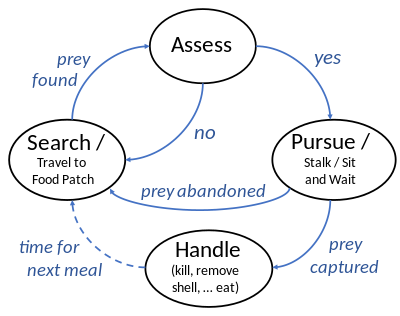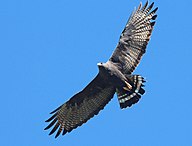Ambush predator

Ambush predators or sit-and-wait predators are
The ambush is often opportunistic, and may be set by hiding in a burrow, by camouflage, by aggressive mimicry, or by the use of a trap (e.g. a web). The predator then uses a combination of senses to detect and assess the prey, and to time the strike. Nocturnal ambush predators such as cats and snakes have vertical slit pupils helping them to judge the distance to prey in dim light. Different ambush predators use a variety of means to capture their prey, from the long sticky tongues of chameleons to the expanding mouths of frogfishes.
Ambush predation is widely distributed in the
.Strategy

Ambush predators usually remain motionless (sometimes hidden) and wait for prey to come within ambush distance before pouncing. Ambush predators are often camouflaged, and may be solitary. Pursuit predation becomes a better strategy than ambush predation when the predator is faster than the prey.[2] Ambush predators use many intermediate strategies. For example, when a pursuit predator is faster than its prey over a short distance, but not in a long chase, then either stalking or ambush becomes necessary as part of the strategy.[2]
Bringing the prey within range
Concealment
Ambush often relies on concealment, whether by staying out of sight or by means of camouflage.
Burrows
Ambush predators such as
Trapdoor spiders excavate a burrow and seal the entrance with a web trapdoor hinged on one side with silk. The best-known is the thick, bevelled "cork" type, which neatly fits the burrow's opening. The other is the "wafer" type; it is a basic sheet of silk and earth. The door's upper side is often effectively camouflaged with local materials such as pebbles and sticks. The spider spins silk fishing lines, or trip wires, that radiate out of the burrow entrance. When the spider is using the trap to capture prey, its chelicerae (protruding mouthparts) hold the door shut on the end furthest from the hinge. Prey make the silk vibrate, and alert the spider to open the door and ambush the prey.[7][8]
Camouflage
Many ambush predators make use of
Aggressive mimicry

Many ambush predators actively attract their prey towards them before ambushing them. This strategy is called aggressive mimicry, using the false promise of nourishment to lure prey. The alligator snapping turtle is a well-camouflaged ambush predator. Its tongue bears a conspicuous pink extension that resembles a worm and can be wriggled around;[17] fish that try to eat the "worm" are themselves eaten by the turtle. Similarly, some reptiles such as Elaphe rat snakes employ caudal luring (tail luring) to entice small vertebrates into striking range.[18]
The zone-tailed hawk, which resembles the turkey vulture, flies among flocks of turkey vultures, then suddenly breaks from the formation and ambushes one of them as its prey.[19][20] There is however some controversy about whether this is a true case of wolf in sheep's clothing mimicry.[21]
Traps
Some ambush predators build traps to help capture their prey. Lacewings are a flying insect in the order Neuroptera. In some species, their larval form, known as the antlion, is an ambush predator. Eggs are laid in the earth, often in caves or under a rocky ledge. The juvenile creates a small, crater shaped trap. The antlion hides under a light cover of sand or earth. When an ant, beetle or other prey slides into the trap, the antlion grabs the prey with its powerful jaws.[27][28]
Some but not all
Detection and assessment

Ambush predators must time their strike carefully. They need to detect the prey, assess it as worth attacking, and strike when it is in exactly the right place. They have evolved a variety of adaptations that facilitate this assessment. For example,
The deep-sea tripodfish Bathypterois grallator uses tactile and mechanosensory cues to identify food in its low-light environment.[33] The fish faces into the current, waiting for prey to drift by.[34][35][36]
Several species of
Capturing the prey
Ambush predators often have adaptations for seizing their prey rapidly and securely. The capturing movement has to be rapid to trap the prey, given that the attack is not modifiable once launched.[6][37] Zebra mantis shrimp capture agile prey such as fish primarily at night while hidden in burrows, striking very hard and fast, with a mean peak speed 2.30 m/s (5.1 mph) and mean duration of 24.98 ms.[37]
All fishes face a basic problem when trying to swallow prey: opening their mouth may pull food in, but closing it will push the food out again.
Taxonomic range
Ambush predation is widely distributed across the animal kingdom. It is found in many vertebrates including fishes such as the frogfishes (anglerfishes) of the sea bottom, and the pikes of freshwater; reptiles including crocodiles,[44] snapping turtles,[45] the mulga dragon,[46] and many snakes such as the black mamba;[47] mammals such as the cats;[48] and birds such as the anhinga (darter).[49] The strategy is found in several invertebrate phyla including arthropods such as mantises,[50][51][52] purseweb spiders,[53] and some crustaceans;[3] cephalopod molluscs such as the colossal squid;[54] and starfish such as Leptasterias tenera.[55]
See also
References
- ISBN 9780198030133. Archived from the original(PDF) on 12 July 2018. Retrieved 20 September 2018.
- ^ S2CID 13809116.
- ^ PMID 23175528.
- ^ "Trapdoor spiders". BBC. Retrieved 12 December 2014.
- ^ "Trapdoor spider". Arizona-Sonora Desert Museum. 2014. Retrieved 12 December 2014.
- ^ PMID 26117833.
- ^ "Trapdoor spiders". BBC. Retrieved December 12, 2014.
- ^ "Trapdoor spider". Arizona-Sonora Desert Museum. 2014. Retrieved December 12, 2014.
- S2CID 214302722.
- ^ Froese, Rainer; Pauly, Daniel (eds.) (2013). "Gillellus uranidea" in FishBase. April 2013 version.
- S2CID 30229791.
- ^ World Database of Marine Species: Spiny devil fish Archived 2012-03-04 at the Wayback Machine. Accessed 03-22-2010.
- ^ Michael, Scott (Winter 2001). "Speak of the devil: fish in the genus Inimicus" (PDF). SeaScope. 18. Archived from the original (PDF) on 2011-07-13. Retrieved 2010-03-27.
- ^ WetWebMedia.com: The Ghoulfish/Scorpion/Stonefishes of the Subfamily Choridactylinae (Inimicinae), by Bob Fenner. Accessed 03-27-2010.
- .
- ISSN 1568-5381.
- S2CID 49305881.
- ^ Mullin, S.J. (1999). "Caudal distraction by rat snakes (Colubridae, Elaphe): A novel behaviour used when capturing mammalian prey". Great Basin Naturalist. 59: 361–367.
- ISBN 978-0-674-04379-4.
Others rely on the technique adopted by a wolf in sheep's clothing—they mimic a harmless species. ... Other predators even mimic their prey's prey: angler fish (Lophiiformes) and alligator snapping turtles Macroclemys temmincki can wriggle fleshy outgrowths of their fins or tongues and attract small predatory fish close to their mouths.
- JSTOR 1365357.
- ^ Clark, William S. (2004). "Is the zone-tailed hawk a mimic?". Birding. 36 (5): 495–498.
- .
- ^ Annandale, Nelson (1900). "Observations on the habits and natural surroundings of insects made during the 'Skeat Expedition' to the Malay Peninsula, 1899–1900". Proceedings of the Zoological Society of London. 69: 862–865.
- S2CID 2228423.
- ISBN 978-1-4833-8898-4.
In aggressive mimicry, the predator is 'a wolf in sheep's clothing'. Mimicry is used to appear harmless or even attractive to lure its prey.
- PMID 28835630.
- ^ "Video of antlion larva ambushing an ant". National Geographic. Archived from the original on June 17, 2014. Retrieved November 30, 2014.
- ^ "Antlion ambush". BBC. 26 January 2012. Retrieved November 30, 2014.
- S2CID 19631772.
- ^ PMID 26601232. Supplement: List of species by pupil shape.
- .
- .
- ISBN 0-12-350440-6.
- ISBN 978-0-7787-4501-3.
- ISBN 0-8225-2499-6.
- ISBN 0-521-33665-1.
- ^ PMID 23175528.
- ^ ISBN 978-0-520-95738-1.
Chameleons may also employ a form of movement-based camouflage, ... [they] often rhythmically rock backward and forward as they walk ... [perhaps] imitating a swaying leaf ... moving in the breeze ... The behavior is widespread in highly cryptic, generally slow-moving, ambush predators, notably chameleons and some snakes and mantids
- S2CID 21033176.
- ^ Anderson, Christopher V. (2009) Rhampholeon spinosus feeding video. chamaeleonidae.com
- ^ PMID 15209111.
- ^ PMID 20212130.
- ^ Bray, Dianne. "Eastern Frogfish, Batrachomoeus dubius". Fishes of Australia. Archived from the original on 14 September 2014. Retrieved 14 September 2014.
- ^ "Nile Crocodile: Photos, Video, E-card, Map – National Geographic Kids". Kids.nationalgeographic.com. 2002. Archived from the original on 2009-01-16. Retrieved 2010-03-16.
- ^ "Common Snapping Turtle". Canadian Museum of Nature. 2013. Retrieved December 2, 2014.
- ISBN 9781920694746.
- ISBN 9780736821377. Retrieved 2010-05-19.
- ^ Etnyre, Erica; Lande, Jenna; Mckenna, Alison. "Felidae | Cats". Animal Diversity Web. Retrieved 28 September 2018.
- .
- ^ "Praying mantis ambushes a grasshopper". National Geographic. Archived from the original on April 14, 2014. Retrieved November 30, 2014.
- ^ "Nature wildlife: Praying mantis". BBC. Retrieved November 30, 2014.
- ^ "How the praying mantis hides". Pawnation. Retrieved November 30, 2014.
- ISBN 9780313339226.
- ^ Bourton, J. (2010). "Monster colossal squid is slow not fearsome predator". BBC. Retrieved December 1, 2014.
- JSTOR 1540983. Archived from the originalon 2015-09-23. Retrieved 2014-12-01.
External links
- Predation lecture University of Washington







